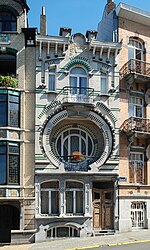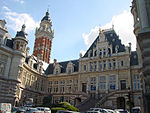Albert premetro station
Belgian railway station stubsBrussels Metro stubsBrussels metro stationsForest, BelgiumPages with no open date in Infobox station ... and 1 more
Saint-Gilles, Belgium

The Albert premetro station is an underground tram station located on the border between the municipalities of Saint-Gilles and Forest in Brussels, Belgium. The station is at the crossroad between the Avenue Albert/Albertlaan on the greater ring road and the Chaussée d'Alsemberg/Alsembergsesteenweg between the Forest park and the Saint-Gilles prison. The station is the last stop south of the North-South Axis, a tram tunnel crossing Brussels city center from Albert to the Brussels-North railway station. It is on tram routes 3 and 4 and evening route 33. There is a connection at ground level with tram route 51 as well as bus routes 48 and 54.
Excerpt from the Wikipedia article Albert premetro station (License: CC BY-SA 3.0, Authors, Images).Albert premetro station
Chaussée d'Alsemberg - Alsembergse Steenweg,
Geographical coordinates (GPS) Address Nearby Places Show on map
Geographical coordinates (GPS)
| Latitude | Longitude |
|---|---|
| N 50.82139 ° | E 4.34194 ° |
Address
Albert
Chaussée d'Alsemberg - Alsembergse Steenweg
1190
Belgium
Open on Google Maps





